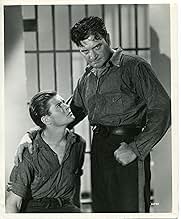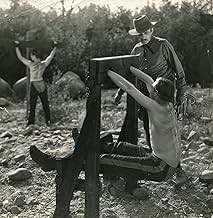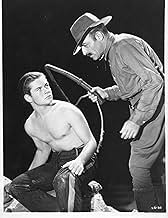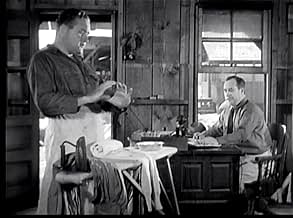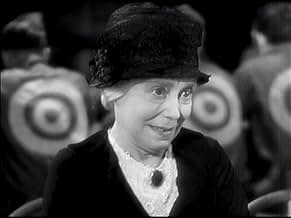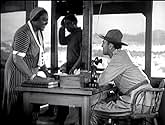Aggiungi una trama nella tua linguaChain gang prisoners forced to construct a "liberty highway" for their overseer chasten under his brutal stewardship, causing Duke Ellis to mastermind a mass riot.Chain gang prisoners forced to construct a "liberty highway" for their overseer chasten under his brutal stewardship, causing Duke Ellis to mastermind a mass riot.Chain gang prisoners forced to construct a "liberty highway" for their overseer chasten under his brutal stewardship, causing Duke Ellis to mastermind a mass riot.
- Regia
- Sceneggiatura
- Star
- Premi
- 1 vittoria in totale
- Rascal's Sweetheart at Visitor's Center
- (non citato nei titoli originali)
- Hunt Club Manager on Telephone
- (non citato nei titoli originali)
- Singer in Etude Ethiopian Chorus
- (non citato nei titoli originali)
- Singers of the Spirituals
- (non citato nei titoli originali)
- Turkey Neck Burgess - the Cook
- (non citato nei titoli originali)
Recensioni in evidenza
Hell's Highway opens with newspaper stories depicting chain gang abuses - and unlike most films, it uses real newspapers such as the Seattle Post-Intelligencer. Richard Dix is "Duke" - a hardened criminal, not an innocent victim of injustice, but it's never mentioned if he's committed any crimes worse than bank robbery. Dix is better here than in some other films in which I've seen his over-emoting - such as "Cimarron" which I've found almost unwatchable.
Early scenes in the film have Charles Middleton as Matthew - Ming the Merciless - as a character who seems to predate John Carradine's "Casey" in "The Grapes of Wrath" in being a rather touched preacher. He even resembles the lanky Carradine and coincidentally, Middleton also happens to appear in 1932's most famous chain gang film. Duke involves Matthew in a plan to aid his escape, but Duke turns back when he sees his younger brother Johnny (played by Tom Brown) has just arrived in the holding pen. While Duke tries to keep his sibling on the straight and narrow, he receives the wrath of his fellow prisoners who think that he's sold out to the screws. C. Henry Gordon, so memorable in a number of Charlie Chan films, is the primary villain, although Oscar Apfel's "Billings" - a contractor relying on convict labor is really the one setting policy. Wonder if he's the one who decided to have the prisoners wear large circular targets on their shirt backs, he's sure proud of his sweat box used for discipline.
Although the story may now seem by-the-numbers, it must have been fresh in 1932 being the first film to depict the horrors of the chain gang. Although not as hard hitting as the Warner film, it's hardly as "viewer friendly" as the much later "Cool Hand Luke." RKO's film may not have broken a thousand chains as did the Warner classic, but it makes a great companion piece, and is one of the best examples of a rival studio attempting to tread on Warner territory. There are some quick cuts, which combined with the running time of only 62 minutes, that give the impression that the film may have been longer before release - Dix was too big a property for a programmer.
- The headlines in the opening sequence are from real newspapers, and refer to the Arthur Maillefert case which shocked the nation. On June 3, 1932, Maillefert was put in a shed similar to the one we see in the movie, with a chain wrapped around his neck and wooden stocks around his feet, and he died within an hour. The first article shown is from the Seattle Post-Intelligencer, "Prison Guards Accused of Murder As Tortured Youth Dies Chained In Sweat Box", and if you search for the next one, "Dark Age Tortures Revealed in Prison Camp Death Quiz", you'll see it's on the front page of the San Francisco Examiner from July 10, 1932. Filmmakers moved quickly; this movie was released September 23, 1932.
- The moment when a guard is about to whip the main character (Richard Dix), but hesitates. The camera pans down and we see a large tattoo on his back with the American flag, and the words "42nd Machine Gun Co. 167th Inf." We don't know much else about this guy and the film doesn't describe too much about his crimes, except that they're numerous and he's "habitual", destined for a life sentence - but finding out that he's a veteran humanizes him, and also points out that criminals have also done positive things in their lives. Given the horrifying outcome of the 'Bonus Army' encampment in Washington D.C. in July, 1932, this image would likely have resonated even more with filmgoers at the time.
- During the jail break the deaf prisoner is hiding in the tall grass, and doesn't see a couple of guys come up behind him. They tell him to "put 'em up", and of course he doesn't because he can't hear them, so they shoot him. It's another case of not knowing everything about someone else, and either misinterpreting or not understanding their actions as a result.
- I loved the treatment of African-American in the film. One wisely comments that the guards are more concerned with the way mules are treated than convicts, because mules cost money and the men are free. Another says to his visiting wife that "Sweetheart, you don't how tired a man does get when he don't get no loving," which in a simple way helps us empathize. I also loved the scenes where we hear groups singing the blues, and during one of them, an artist drawing a few funeral scenes.
- Lastly, something about seeing C. Henry Gordon trying to learn the violin at night using the "E-Z Method" made me smile; perhaps despite his inhumane ways, the film tries to point out he's human too.
I was less enamored with a few comments about women, one of which being that a lot of crime is done on behalf of women, and another that prison is a good way to escape being married to three women, since, you know, women are such balls and chains themselves. "I Am a Fugitive from a Chain Gang", also from 1932, is a better film with more emotional power, but this one is worth seeing too.
Catch those rolling cages the convicts are kept in. They'd even be sub-standard for wild animals in a circus. But then, this is a down and dirty look at a chain-gang work crew, circa 1932, where shooting a con is made easier by the bull's eye on their backs. And if a con misbehaves, like not working fast enough to make the road contractor more money, it's a time in the sweat box, which is like doing time in an upright coffin-- you walk in, they carry you out. Now all this might sound like a lefty screenwriter's fevered dream, but the prologue assures us that the abuses are based on fact.
Then too, the cons are toiling in the middle of one ugly nowhere, and when the place catches fire, it's big enough to take down Chicago. No wonder the cons are looking to escape, and being a prison movie, they do. In my book, the best scene is the luckless deaf guy who never hears the bullet coming. I hope his last minute mumbo-jumbo was enough to get him past the pearly gates—it's a moving and inspired moment.
Then too, Dix makes a convincing boss con, as does C. Henry Gordon as the brutal boss muleskinner. But my money's on the cadaverous Charles Middleton (the hermit) who's on prison vacation from three wives and apparently dabbles in the black arts as when he foresees doom in the stars. His graveyard voice and grim reaper demeanor are like no other and can chill you to the proverbial bone.
Of course, being a Rowland Brown directed film, there are passing references to homo-erotic behavior, (see especially his Blood Money {1933}). All in all, he manages to blend the diverse story elements, including the black men's chorus, into a forcefully memorable whole. Too bad his directing career was so brief. He was that rarest bird in old Hollywood—a genuinely independent spirit.
It's a bang-up 60-minutes from struggling little RKO that takes no prisoners, so to speak. More importantly, there's something topical about tax-supported labor being used to enrich private contractors, as in the movie. Too bad, this over-looked little gem was assigned to pre-Code oblivion.
Lo sapevi?
- QuizRKO executives were concerned about a possible plagiarism suit by the author of the book and the movie version Io sono un evaso (1932) in production at Warner Bros. at the time. Some deletions and changes were made until they were satisfied that no legal action would be taken.
- Citazioni
Duke Ellis: [Chatting with a convicted bigamist] How many women did you really marry?
Matthew the Hermit: How many banks did you really rob?
Duke Ellis: Never more than one at the same time.
Matthew the Hermit: It takes nerves of steel to rob a bank.
Duke Ellis: It takes a lot of backbone to keep three wives happy.
Matthew the Hermit: Yea, Brother!
I più visti
- How long is Hell's Highway?Powered by Alexa
Dettagli
- Data di uscita
- Paese di origine
- Lingue
- Celebre anche come
- Chain Gang
- Luoghi delle riprese
- Azienda produttrice
- Vedi altri crediti dell’azienda su IMDbPro
- Tempo di esecuzione1 ora 2 minuti
- Colore
- Proporzioni
- 1.37 : 1
Contribuisci a questa pagina


